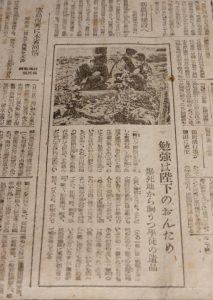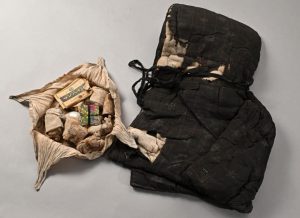Documenting Hiroshima of 1945: Early December, belongings of students continue to be found in ruins
Dec. 5, 2024
by Minami Yamashita, Staff Writer
In early December 1945, just prior to four months since the atomic bombing, the belongings of junior high school students and female students killed in the atomic bombing while mobilized for building-demolition work were enshrined on a street corner amid the ruins of the Dobashi area (in Hiroshima City’s present-day Naka Ward). The Chugoku Shimbun edition dated December 2 carried a photograph of people at the site placing their hands together in prayer.
On August 6, in the surrounding area, students from different schools including First Hiroshima Prefectural Girls’ High School (Prefectural Girls’ school; present-day Minami High School) and Hiroshima Municipal Middle School (present-day Motomachi High School) had been mobilized for building-demolition work. Because the area was located around 800 meters from the hypocenter, countless lives were lost there. More than three months after the bombing, when residents of the area sorted out the ruins, the belongings of students were unearthed one after the other.
“Clothes, shoes, headbands, gloves, socks, air-raid hoods, hats, wallets, passholders, pocket notebooks, etc.,” was a list of the belongings according to the same December 2 article. Reported to have been inscribed in a pocket notebook found there was the statement, “What is the purpose of studying? To repay our great obligation to the Emperor.” Flowers and tangerine oranges were offered by local residents.
According to the Minami School’s Centennial Commemorative Magazine, published in 2001, which conveys the school’s situation at the time of the atomic bombing, there were instances of student belongings unaffected by the fires after the bombing. The students had changed from their school uniforms to work clothes and placed their uniforms and other belongings underneath a row of trees before starting work. Also found at the site were the summer school uniform, an air-raid hood, and contents of the first-aid kit belonging to Yoko Moriwaki, 13 at the time, a first-year student at the school. The belongings were returned from the school to her surviving family.
In her diary entry dated August 5, Ms. Moriwaki had written, “Starting tomorrow is the organization of materials following demolition of structures. I want to work hard. The end.” The following day, she experienced the atomic bombing and died that night at a shelter. Her family held on for many years to her summer school uniform and air-raid hood. In 2018, her older brother, Koji Hosokawa, who died in 2023 at the age of 95, donated the articles to the Hiroshima Peace Memorial Museum. Yo Hosokawa, 65, Mr. Hosokawa’s oldest son who lives in Hiroshima’s Naka Ward, said, “Through her belongings, Yoko remained alive in the hearts of our grandparents and father.”
(Originally published on December 5, 2024)
In early December 1945, just prior to four months since the atomic bombing, the belongings of junior high school students and female students killed in the atomic bombing while mobilized for building-demolition work were enshrined on a street corner amid the ruins of the Dobashi area (in Hiroshima City’s present-day Naka Ward). The Chugoku Shimbun edition dated December 2 carried a photograph of people at the site placing their hands together in prayer.
On August 6, in the surrounding area, students from different schools including First Hiroshima Prefectural Girls’ High School (Prefectural Girls’ school; present-day Minami High School) and Hiroshima Municipal Middle School (present-day Motomachi High School) had been mobilized for building-demolition work. Because the area was located around 800 meters from the hypocenter, countless lives were lost there. More than three months after the bombing, when residents of the area sorted out the ruins, the belongings of students were unearthed one after the other.
“Clothes, shoes, headbands, gloves, socks, air-raid hoods, hats, wallets, passholders, pocket notebooks, etc.,” was a list of the belongings according to the same December 2 article. Reported to have been inscribed in a pocket notebook found there was the statement, “What is the purpose of studying? To repay our great obligation to the Emperor.” Flowers and tangerine oranges were offered by local residents.
According to the Minami School’s Centennial Commemorative Magazine, published in 2001, which conveys the school’s situation at the time of the atomic bombing, there were instances of student belongings unaffected by the fires after the bombing. The students had changed from their school uniforms to work clothes and placed their uniforms and other belongings underneath a row of trees before starting work. Also found at the site were the summer school uniform, an air-raid hood, and contents of the first-aid kit belonging to Yoko Moriwaki, 13 at the time, a first-year student at the school. The belongings were returned from the school to her surviving family.
In her diary entry dated August 5, Ms. Moriwaki had written, “Starting tomorrow is the organization of materials following demolition of structures. I want to work hard. The end.” The following day, she experienced the atomic bombing and died that night at a shelter. Her family held on for many years to her summer school uniform and air-raid hood. In 2018, her older brother, Koji Hosokawa, who died in 2023 at the age of 95, donated the articles to the Hiroshima Peace Memorial Museum. Yo Hosokawa, 65, Mr. Hosokawa’s oldest son who lives in Hiroshima’s Naka Ward, said, “Through her belongings, Yoko remained alive in the hearts of our grandparents and father.”
(Originally published on December 5, 2024)









